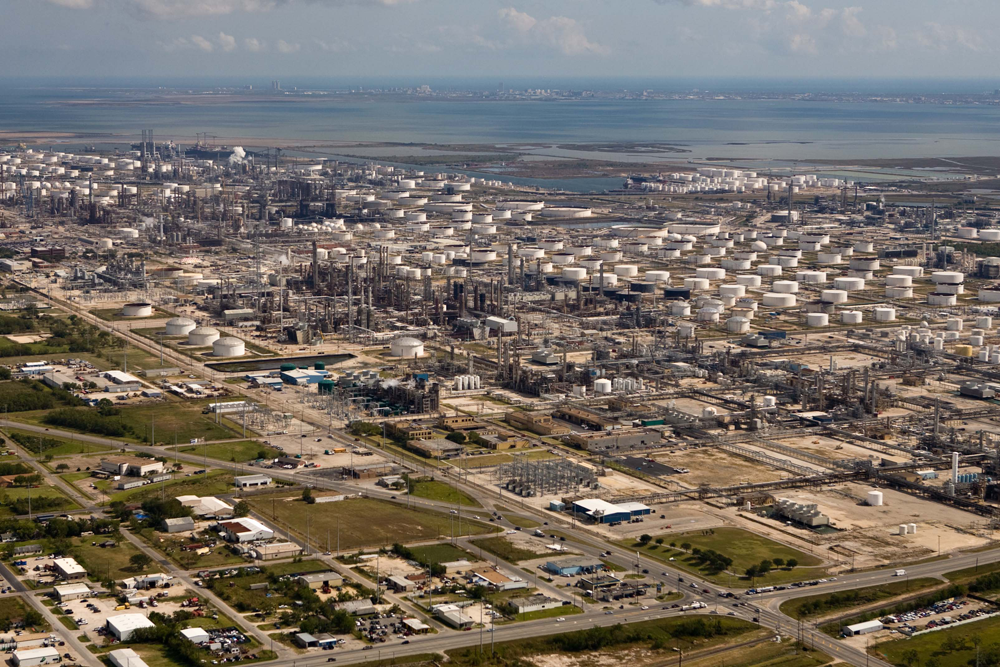Center for Land Use Interpretation
Blaffer Gallery, Houston, USA
Blaffer Gallery, Houston, USA

The Houston oil infrastructure is well known as being ‘far out’. Local relief from Texas-sized boredom includes midnight marijuana-laced drives along the highways southeast of the city, where the world’s largest concentration of oil refineries, chemical plants and related shipping facilities loom and glimmer like an inexhaustible furnace. Sprawling for some 50 miles towards the Gulf of Mexico, this superlatively unnatural landscape is an obvious target for the documentary eye and peripatetic reach of the Center for Land Use Interpretation (CLUI).
Given that they have visited the region before in order to augment their database, it is surprising that, having been invited back for a year-long residency for which they established a field office on the banks of Buffalo Bayou/Houston Shipping Channel, CLUI’s take, as represented in the Blaffer Gallery’s ‘Texas Oil: Landscape of an Industry’, left much to the imagination.
First encounters with the exhibition occurred, appropriately, outside the gallery, where an automobile-sized, orange UFO was squatted with scant explanation. The ringed, windowed spheroid was actually an oil-rig survival capsule; safety colouring, a pathetic propeller and manufacturer’s labelling betraying its purpose as a marine rescue vehicle. This initial confusion, really a CLUI-intended conflation of science fiction and fact, was amplified inside the gallery.
The Blaffer’s modest second-floor galleries were haunted by an eerie metallic din, bleeding from the soundtrack to Houston Petrochemical Corridor: From the East 610 Loop to the Highway 146 Bridge (all works 2008), a 12-minute ‘land-scan’ tracking the above-mentioned trip beloved of local stoners. Shot from a helicopter with a gyro-stabilized HD camera, the view slides, shifting rather than turning, over machine-megalopolises of cracking towers, pipes, and holding tanks, as well as shocks of swamp green. The footage is redolent of Werner Herzog’s 1992 film of the Kuwait oil fields, Lessons of Darkness. However CLUI’s airborne lens maintains an uncanny evenness that is otherworldly in itself, and ultimately produces a gaze both distant and cold.
This was echoed in Companies, a scatter of 40 framed, letter-sized photographs with corresponding wall texts. Together the images catalogue the Texas office facades and gated headquarters entries of ‘upstream’ (extraction) and ‘downstream’ (processing) industry players. The concrete, steel and glass corporate faces of Exxon Mobil, Goodyear, Halliburton and Boots & Coots are recorded not with the omniscient overviews offered by maps or aerial photos, but with first-hand, on-the-ground accounting. It is a human perspective, but again undeniably and self-consciously that of the alien visitor or scout.
‘Texas Petrochemicalscape: A Portrait Gallery of Selected Petrochemical Sites’ also apes the look of surveillance imaging. A line of 56 aerial photographs ring the gallery, starting with an image taken of Rhodia, Houston, at the entrance, then spanning the state’s strategic oil reserves, BP complexes, and Permian Basin pumpjacks, ending with Valero, El Paso. In the middle of the gallery is the centre of this Texan universe: not quite ‘TX Sweet Light Crude’, but 42 gallons of spent lubricating oil from the University of Houston ‘motor pool’ raised on a central plinth in a clear plastic barrel. It is a final science-fiction token: a slick, silent, black monolith.
Much is made – especially in the accompanying George H.W. Bush-endorsed catalogue – of the CLUI’s ‘objective’ lens, its directness and impartiality in documentation, its drive towards the denotative. CLUI’s appropriation of museological authority and the voice of the institutional expert regularly read more genuine than tongue-in-cheek, more interested in adopting approaches that fall just past the purview of natural history and the art world than offering ironic commentary on epistemology. But in ‘Texas Oil’, CLUI’s mission skews towards aesthticization, specifically a sci-fi sublime. This makes for a sharp-looking exhibition, but where exactly does it leave us? Houston is ‘Space City’ and a CLUI wall text makes the valid point that the petrochemical industry, as a field of human endeavor and ingenuity, surpasses all interplanetary aims in scope and scale. A nod to the CLUI’s own Robert Smithson-esque roots, the science-fiction aspects of ‘Texas Oil’, like Herzog’s Lessons of Darkness, offers a way of grasping what Rod Serling called the ‘improbable made possible’. But where Herzog’s inversion of Kuwaiti oil fire fiction and fact affects a poignant absurdity, CLUI’s endeavor never quite delivers. Save for income, employment, and historical stats accompanying Comanies, and a hallway of beguiling pipeline maps, the exhibition lacks didactic and encyclopedic resource materials, exerting its power instead as a set of astonishing images. For a subject premised on penetration, ‘Texas Oil’ skirts a surface-only read. Moreover, despite the promise of advertised bayou boat tours, the show itself remains physically, sensorially and politically clean. If CLUI won’t engage directly in critique, it need not lure us into further mystification; viewers already feel disempowered by an oil industry making record profits in 2008. If anything, it is precisely this lack of information, rather than spectacular image, by which ‘Texas Oil’ incites one to journey into the petrochemicalscape firsthand.
























